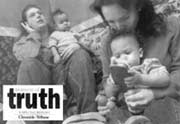Marion’s Moment of Truth
By Dana Clark Felty
Pew Center
 Page one of the Marion, IN Chronicle-Tribune on New Year’s day featured the standard photo: the first baby of the millennium. In this case, twins had been born and the photo showed a happy mother and father with the newborns and a stash of gifts.
Page one of the Marion, IN Chronicle-Tribune on New Year’s day featured the standard photo: the first baby of the millennium. In this case, twins had been born and the photo showed a happy mother and father with the newborns and a stash of gifts.
Marion appeared to be twice blessed. But, Chronicle-TribuneExecutive Editor Juli Metzger quickly learned that the photo did not reflect the full story of the twins’ lives.
The 21-year-old mother, Stephanie Watkins, was not married to the father. She was living alone in a two-bedroom apartment on $376 a month in welfare payments. Her mother and father tried to help, but Stephanie’s 17-year-old sister also had an 18-month-old child. The twins were the second and third child for Watkins and numbers eight and nine for the father.
Moreover, an angry reader had complained about the paper’s front-page coverage of an interracial couple: Watkins is white; the twins’ father is black.
For Metzger, it was a moment of truth that led to a yearlong examination into the economic hardships of Marion and surrounding Grant County.
“That, in a nutshell, was why we decided on ‘Moment of Truth.’ It was our obligation, ” Metzger now says. “We felt like we had approached the edge of a cliff so slowly nobody realized how close we were to falling over.”
“The same people were working on the same problems and everyone was growing weary,” she says. Staff members also sensed that their reporting wasn’t getting at underlying issues.
“Moment of Truth,” a series of 10 special sections published between March and December 2000, was the work of a core group that included a project leader, six to eight reporters, copy editors and designers – all drawn from a newsroom of only 25 employees.
Among their key findings: Marion had lost more population in the last nine years than any other Indiana city. One in five births at Marion General Hospital in 1999 were to 12- to 19-year-old mothers. Marion is older, poorer and less educated than any other Indiana city. One in five people are functionally illiterate, able to sign their names but unable to fill out job applications. One in three do not have a high school diploma, only 11% have college degrees.
The newspaper sought public input on how to address the problems by sponsoring a dozen discussion groups in Marion and Grant County. In addition, the Chronicle sought input from business groups, non-profits and government agencies. In some cases, says Metzger, “We put them in the same room, made introductions and walked away.”
The editorial pages of the newspaper took note of a “new attitude” of cooperation.
When the first article was published in March 2000, “It felt like we were beating up on the community,” Metzger says, adding, “Some members of the community wanted to lynch us.” She took pains to explain to community leaders why the newspaper was doing the series.
Grant County Historian Richard Simons calls the series hard-hitting but also effective. “They’ve talked with gloves off, and it’s beginning to focus attention on community problems and bring people and organizations together to solve these problems,” he says.
The series so impressed Jerry Pattengale, associate dean at Indiana Wesleyan University, he ordered 700 copies and delivered them to professors on campus. “I wanted to close the chasm between the campus and the community,” he says. “In Marion, the city was going in one direction and campus in another.”
The series was also the focus of a faculty retreat that led to a new requirement that students volunteer in the community. Faculty also are volunteering.
“We really turned a corner here with people outside the political arena,” Simons says. “The series highlighted those folks who were genuinely trying to help. Some of them were millionaires and others had no money.”
The Chronicle and General Motors, the community’s second largest employer, brought in a consultant to help city leaders “bury the hatchet.” In addition, the Community Foundation of Grant County dedicated $60,000 to Framework for Change, a program that brings citizens together to find solutions to local problems.
In Metzger’s view, the series’ biggest impact has been to trigger an ongoing dialogue about how to solve community problems. “I think we have a better understanding of what the community is like,” she says.
As Metzger told APME last year, “In our noble attempt to remain objective, we have collectively become unattached. As unattached members of the community, we take no risks. If we ourselves take no role in trying to solve community problems, readers will resent us for suggesting that they and others should.”
With “Moment of Truth,” she says, “We didn’t want to do just another report. We really wanted some action to take place.”
Several Marion residents want to nominate the series for a Pulitzer Prize. Metzger considers this a green light for the newspaper’s new civic direction: “Obviously, they feel like it’s good journalism.”
